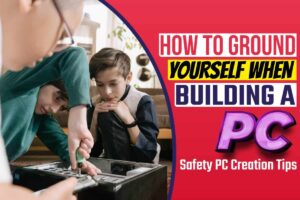
In recent years, most users prefer to construct their PCs to ensure they meet their specific needs. This is a good idea, and it will work well for you if you know what you are doing and do it right.
A computer uses electricity thus, you have to be careful when connecting it to ensure that the components don’t get fried.
Part of the precaution is grounding yourself to be safe from static electricity that could shake you up. Let’s see how you can do this;
How To Ground Yourself When Building A PC
It is important to ground yourself when building a PC since it will keep you safe from what could be a very painful ordeal. There are several ways to ground yourself, and we will discuss them all in detail; let’s jump into it;
You can use the power outlet to ground the PC. Turn off a Power supply Unit of any other PC you could have. This ensures that there is no current going into your PC; thus, you will be safe from the main current. Plug the Power supply Unit into a working power outlet, and most of the static charge will get pulled out of your PC. Touch a metallic part of your PC to get the rest and yourself earthed since metals can transmit the static charges. You need to make sure you are standing on the ground, wood, tile, or concrete, not a carpet since they will not earth you.
Keep one hand on the PSU while you work or touch it every few seconds to ensure no static charge build-up.
You can also use an anti-static wrist wrap to earth yourself. The whole point of Earthing yourself is that you pass any static energy on your PC down to the earth so it doesn’t fry your equipment.
An anti-static wrist band makes this easier for you since it is elastic and attached to your wrist.
You only need to attach it to a metallic part of the PSU, and you can work without worrying about the static charge.
This will be more convenient since you won’t have to worry about touching the PSU as you work.
It also means that there will be no build-up of static charge since the cable is always connected. It’s the best choice if you have a carpet.
Don’t wear socks or cotton gloves when working on your computer. Socks create a lot of static energy when rubbed against other surfaces; thus, they will not help to ground the static electricity in your computer.
In the same discussion, please don’t work on your PC with a carpet since they generate a lot of static electricity when you rub your feet or hands on them. Close contact could even damage your PC components, so you have to avoid it.
You can use an anti-static floor mat to ground yourself. This is a carpet specially designed to carry any current there could be in your body to the ground, so there is no build-up in you.
What Is Earthing?
Earthing is important, and it is a topic that all electricians and computer technicians will tell you about severally.
But what is earthing really? To understand why it is important, we need to understand it, so let’s get into it.
Earthing is connecting yourself to the earth. An electric current in any form tries to get back to the earth through any medium it can. This static energy in PCs is mostly build-up due to friction with nearby objects.
To earth a PC means to get the static charge present in it and move it to the ground where it can’t do any damage.
This protects the motherboard, all the computer components, and the user. If there were to be a build-up, the charge might get to a lethal level for the components.
When earthing yourself, you take the static charge in you and transmit it to the earth to keep yourself and anything you touch safe.
The electric current looks for a path of least resistance, so you could potentially damage sensitive electrical equipment if you are not earthed.
Having said this, you need to stand on a surface that will help you get rid of the charge. Like wood or concrete, surfaces like carpets or socks will only generate more static electricity, which is bad for you and your devices.
Beginner’s Guide To Building Your PC
Building your custom PC at home can be a tremendous responsibility and, if handled incorrectly, could be costly to you.
There are numerous components of different specs for you to choose from, and they will determine your PC’s performance.
PCs will vary in size and design depending on what the user has planned for them, but here are some tips that apply to all beginner-PC builders;
- Get as many details as you can on every component. Knowing what you want along with its compatibility will make assembly easier for you. Buying the wrong parts will force you to return to the store and replace them, which will be frustrating.
- Make sure you ground yourself and your equipment to be safe from static charges. This applies to all electronics, and it could be a lifesaver if there is a mishap with the mains power. Make sure your sensitive components are kept safe as well, especially the motherboard. The motherboard has many sensitive components, such as the RAM, and they can get fried easily, yet they are not cheap. Keep it on a non-conductive surface or in its box.
- The fan orientation. Fans are important in cooling your processor, especially if you plan to overclock your PC. You need to get details on various fan orientations so that you land on one that will cool your PC the best way possible.
- Be wise about your use of thermal paste. You would have to use different brands of thermal paste depending on the speed you intend to run your PC at, and most PCs have some pre-applied thermal paste. When you need to re-apply some thermal paste, don’t use a lot of it. Thermal pastes are very difficult to get out of crevices in general. Use thermal paste the size of a grain of rice, and it should hold for small components, increase only slightly for larger parts.
- Work with magnetic tools; these can be very helpful when dealing with small screws that can drop and get lost. They will also be easier to put in and out of the slots on the PC. A magnetic screw screwdriver will be a good asset should any screws fall into the wrong places. The magnet is not powerful enough to damage your components.
How To Protect Components From Static Electricity
So you have bought an amazing new graphics card with insanely high specs. But then you rub your feet on the carpet and touch the graphics card, and it gets damaged beyond repair. What is your issue? Most probably, it is Static electricity.
You can’t keep frying your devices, so how can you protect delicate components from static electricity? Let us get into the details of this to answer the question;
The first layer of protection is usually some form of foam or bubble wrap. The purpose of this is to keep out any significant charges and protect the package from physical damage. This wrap will come with the components when you buy it.
The next layer of protection is the ESD or the more common anti-static bag. This bag primarily has some conductive material on the outer surface. This conductor allows electrostatic charges to get discharged before they get to the component.
You, therefore, should keep any equipment like hard drives, RAM sticks, or graphics cards inside the anti-static bag whenever they are not in use. Don’t put the devices on top of the paper since their surface is conductive.
Also, avoid turning the bag inside out since you might get its interior charged. For the equipment, handle them by the edges and avoid touching the PCB since it is easier to damage. As always, make sure you ground yourself before working with any equipment.
Conclusion
Grounding yourself while working with computer components is an important consideration. You can use a PSU that is plugged into the mains but turned off to earth yourself. This is an effective way, but you constantly have to touch the PSU.
A more convenient way is using an anti-static wrist band. It comes with an alligator clip so you can attach it to the PSU or any other surface that will discharge you and move freely while getting earthed.
Building your PC can be a fulfilling experience, and it has numerous advantages. You will only enjoy the benefits if you install all the right components with the right configurations. Getting the right tools will make the job go a lot smoother.


